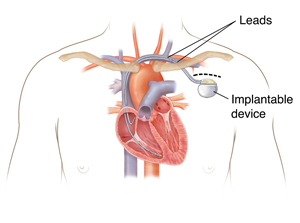Having Lead Extraction
Lead extraction is the removal of wires (leads) from your heart. The wires are part of an implanted cardiac device. They run from the generator (battery and computer) to your heart. These small devices, such as a pacemaker or implanted defibrillator, are put into the chest to help the heart keep a normal rhythm. The leads of a device may need to be removed and replaced if they stop working or become infected or your vein becomes blocked (occluded).

What to tell your healthcare provider
Let your healthcare provider know what other medical conditions you currently have, as well as any prior surgeries you have had, especially those related to your heart and chest. Tell your provider about all the medicines you're taking, especially blood thinners and any nonprescribed medicines or supplements.
Let your provider know if you're pregnant or think you may be pregnant. The imaging used during the procedure uses radiation. This may be a risk to a baby. Your provider may give you a pregnancy test to make sure you aren’t pregnant.
Tests before your procedure
You'll have some tests before your procedure. These may include:
-
Electrocardiogram (ECG) to check your heart rhythm
-
Echocardiography (echo) to look at heart anatomy and function
-
Chest X-ray to visualize the cardiac device and the wires in the heart
-
Venogram to look at the veins around the device
-
Blood tests to check your overall health and prepare for a blood transfusion if needed
Getting ready for your procedure
Don't eat or drink anything after midnight on the night before your procedure. Follow instructions about which medicines to take or stop before the procedure.
On the day of your procedure
Your procedure will be done either by a cardiologist or cardiac surgeon. These are healthcare providers who specializes in heart diseases. They'll work with a team of specialized nurses and technicians. The surgery can be done in several ways. Ask your provider about the details of your surgery. The procedure may take as long as a few hours. In general, you can expect the following:
-
You'll likely have general anesthesia, which includes medicine that allows you to sleep through the surgery, and be placed on a breathing machine. In some cases, general anesthesia won't be used. Instead, you may get medicines that help you relax and sleep, but don't require a breathing machine. Either way, you won't feel pain during the surgery.
-
A provider will watch your vital signs, including your heart rate and blood pressure, during the surgery.
-
Often an IV (intravenous) line is placed in the groin area..
-
If needed, hair may be removed (clipped) from the skin in the area of surgery. Then the skin will be cleaned.
-
Medicine will be given to numb the area.
-
An incision will be made over the site of the cardiac device. Scar tissue and the device will be removed.
-
The leads will then be identified for removal.
-
Using a variety of tools, which may include laser or other mechanical sheaths, the leads will be freed from the blood vessels and heart so that they can be safely removed.
-
Your vital signs will be monitored carefully and ultrasound pictures of the heart may be taken through your esophagus. If complications occur, immediate open heart surgery may need to be done.
-
Depending on your situation, a new lead or leads may be placed and the cardiac device replaced.
-
The skin will then be closed with stitches (sutures) and bandaged.
After your procedure
After surgery, you'll be taken to a recovery room. Nurses will check your breathing, heart rate, and blood pressure. They'll also watch your heart rhythm. You may be given pain medicine if you need it. You may need an echocardiogram and a follow-up chest X-ray to check your heart and lungs. You’ll likely need to stay in the hospital at least one night.
Recovering at home
Follow all the instructions your healthcare provider gives you. Don't get the incision wet until your provider says it's OK. You may also be under activity restrictions if new leads were placed. Ask your provider when you can go back to normal activity. Ask what activities you can safely do in the meantime.
Follow-up care
If you have external stitches, you'll need to have them removed about 1 week after the procedure. Make sure to keep all of your follow-up appointments.
When to call your healthcare provider
Call your provider right away if you have any of these:
-
Bleeding or fluid leaking from the incision
-
Swelling at the incision site
-
Fever of 100.4°F (38.0°C) or higher, or as advised by your provider